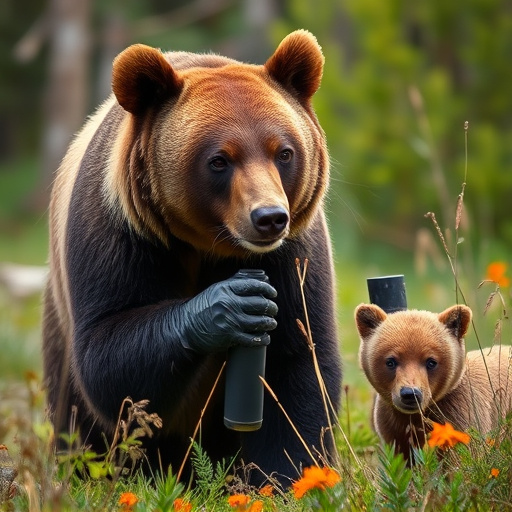Bear spray residue deters wildlife aggression but has short-lived effects. Choosing the right spray and responsible usage minimizes harm to bears and ecosystems while maximizing human safety in bear country. Strategic application, proper training, storage, and disposal methods ensure effective deterrence with minimal environmental impact.
“In wild, untamed environments, encountering bears is a potential hazard. Here, bear spray emerges as an indispensable wilderness safety gear. This article delves into the science behind bear spray residue, its impact on wildlife, and offers a comprehensive guide to choosing, using, and storing it effectively. Understanding how bear spray works and its effects on exposed beings is crucial for responsible outdoor adventurers. Learn to navigate these powerful tools for maximum protection against potential bear encounters.”
- Understanding Bear Spray Residue: How It Works
- Wildlife Impact: What Happens After Exposure
- Choosing the Right Bear Spray for Safety
- Application Techniques: Maximizing Effectiveness
- Responsible Use and Storage Guidelines
Understanding Bear Spray Residue: How It Works
Bear spray residue is a powerful tool for self-defense against aggressive wildlife, but understanding its effects on affected animals is crucial. When bear spray is deployed, it creates a protective barrier by depositing tiny aerosolized droplets containing capsaicin, the active ingredient. This substance is derived from chili peppers and is known for its ability to cause temporary blindness, coughing fits, and severe irritation in humans. Similarly, when wildlife encounters these droplets, they experience a similar reaction, creating a disorienting and painful experience that often drives them away.
While bear spray residue can effectively deter bears and other wildlife, it’s important to note that the impact is usually temporary. The capsaicin irritates the animal’s eyes, nose, and respiratory system, causing them to retreat. However, many animals are resilient and may not be severely affected for long periods. Proper usage and awareness of bear spray residue can ensure safety while minimizing harm to wildlife, fostering a harmonious coexistence in the wilderness.
Wildlife Impact: What Happens After Exposure
When bears are exposed to bear spray residue, their behavior can change significantly. The primary effect is a temporary disruption in their sense of smell and potential taste alterations, which can lead to altered feeding patterns and avoidance behaviors. This impact on their senses makes it harder for them to locate food sources and navigate their environment effectively.
After exposure, bears may exhibit signs of disorientation, increased aggression, or even temporary blindness due to the chemical irritants in bear spray. These effects are usually short-lived, but they highlight the potential consequences of using bear spray as a defense mechanism. Despite being a popular wilderness safety gear item, it’s crucial to remember that bear spray residue can have lasting impacts on wildlife populations and ecosystems.
Choosing the Right Bear Spray for Safety
Choosing the right bear spray is paramount for wilderness safety. When selecting a bear spray, consider factors like canister size, spray pattern, and concentration of capsaicin, the active ingredient. Smaller canisters are ideal for day hikes or backpacking, while larger ones offer more protection for extended outings in grizzly country. Pay close attention to the spray pattern; you want it to cover a wide area and project forward, not upwards, to ensure effective defensive coverage.
Additionally, be mindful of the bear spray residue’s wildlife impact. While capsaicin is non-toxic to humans, it can harm other animals, including non-target species like birds and fish if not used responsibly. Always follow manufacturer instructions for proper application and storage to minimize environmental impact and maximize your safety in bear country.
Application Techniques: Maximizing Effectiveness
Effective application techniques are key to maximizing the effectiveness of bear spray, ensuring both your safety and minimizing wildlife impact. First, always ensure a clear line of sight between you and the approaching bear. Aim for the face and eyes, as this area is highly sensitive. Spraying from close range, around 20-30 feet away, increases the likelihood of successful deterrence.
Remember, bear spray residue can travel up to 30 feet, so it’s crucial not to overspray. Aim deliberately and control the stream to cover the bear’s face and flee in a calculated direction. Practice makes perfect, so familiarize yourself with the spray pattern and range during controlled training sessions before venturing into wilderness areas.
Responsible Use and Storage Guidelines
Using bear spray responsibly is key to minimizing wildlife impact. Always follow guidelines for proper usage, ensuring it’s within close range and aimed at the animal’s face. Never spray indiscriminately or into the air as this can harm innocent bystanders and spread potentially toxic bear spray residue. After use, store bear spray in a secure, sealed container out of reach of children and pets, ideally in a cool, dry place. Disposal methods should adhere to local regulations to prevent contamination of soil and water sources.
Remember, bear spray is a tool for self-defense and should be used as a last resort when facing an aggressive or unexpected bear encounter. Responsible use and proper storage practices contribute to the overall safety of both humans and wildlife, ensuring these essential tools remain effective in emergency situations while minimizing environmental impact from residual chemicals.
Bear spray is a valuable tool for outdoor enthusiasts navigating wild environments. By understanding how bear spray residue works, recognizing its impact on wildlife, and adopting responsible usage practices, individuals can ensure their safety while minimizing harm to these majestic creatures. The right choice of bear spray and proper application techniques are key to effective protection, enabling adventurers to appreciate nature’s beauty without compromising their well-being or contributing to negative Wildlife Impact.
